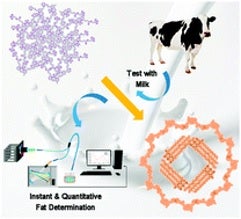On-site instant milk quality control can thus be achieved. Based on the preliminary analysis of the dairy market, there is likely a significant demand for this capability. This could significantly accelerate the primary quality control process while reducing cost, which would help enhance the whole dairy industry.
Prof CHANG’s team has been developing novel and effective molecular fluorescent sensors for various important analytes of societal concerns such as caffeine and date rape drugs, and also environmental pollutants such as bisphenol-A. The method is now widely known as Diversity-Oriented Fluorescence Library Assay (DOFLA), which has pioneered in NUS. The results from this effort will greatly contribute to the number of important compounds that can be speedily and accurately detected in food and beverages, water supply and the environment.

This cartoon describes both chemical and engineering aspect of the milk fat sensor. Initially the sensor is in non-fluorescent aggregated form. With milk fat added, the dye will be disassembled and exhibit its intrinsic fluorescence color. Together with a simple custom-built fluorescence detector, the fluorescence intensity can be measured and the milk quality evaluated on-site. <Image credit: Royal Chemical Society>
Reference
Xu W, Bai J, Peng J, Samanta A, Divyanshu, Chang YT. “Milk quality control: instant and quantitative milk fat determination with a BODIPY sensor-based fluorescence detector.” Chemical Communications 50 (2014) 10398.


